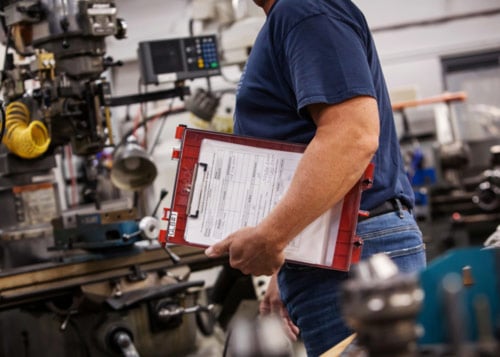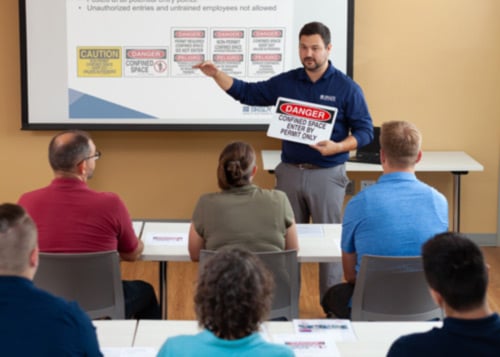Visual Safety 101: Building a Comprehensive Workplace Safety Program
A safe workplace doesn't happen by accident. It's the result of a deliberate, documented and visible safety plan. Building a comprehensive safety program protects your most valuable asset—your employees—and fosters a culture of productivity and trust. It's not just about compliance, it's about ensuring every team member goes home safe at the end of the day.
This guide breaks down the essential steps to building an effective visual safety program, from identifying hazards to implementing specific, OSHA-required plans.
Floor marking is an important part of a safe facility. Check out Brady's complete floor and area marking solutions. Get the BrochureStep 1: Start with a Hazard Assessment
You can't make your facility safer if you don't know where the risks are. The first step is always to conduct a thorough hazard assessment. Walk through your facility and identify potential risks. Common construction and manufacturing workplace hazards include:
- Hazardous Chemicals: Acetone, acids and flammable liquids.
- Powered Industrial Trucks: Forklifts operating near pedestrians.
- Industrial Machinery: Equipment used for cutting, pressing or manufacturing.
- Electrical Hazards: Exposed wiring and high-voltage equipment.
- Working at Heights: Use of ladders, scaffolding or work on elevated surfaces.
- Environmental Risks: Wet floors, noise and extreme temperatures.
This assessment is not a one-time task. It requires ongoing evaluation, especially when you introduce new machinery, reconfigure your layout or change processes.
Step 2: Apply the Hierarchy of Controls
Once you've identified a hazard, the goal is to mitigate it as effectively as possible. The Hierarchy of Controls, a framework endorsed by OSHA and the National Safety Council, provides a systematic approach. It prioritizes the most effective solutions down to the least.
- Elimination: Physically remove the hazard entirely. For example, you could replace older, outdated equipment with modern machines that have updated safety features.
- Substitution: Replace the hazard with a safer alternative. This might mean using a pallet jack instead of a forklift in higher-traffic areas.
- Engineering Controls: Isolate people from the hazard. Installing guardrails on pedestrian walkways and adding shielding around moving machine parts are examples of engineering controls.
- Administrative Controls: Change the way people work to reduce risk. For example, you could restrict unqualified employees from accessing certain work areas or schedule machine maintenance for times when fewer employees are present.
- Personal Protective Equipment (PPE): Equip the worker with protection like safety glasses, earplugs, hard hats and gloves.
Always remember that PPE is the last line of defense. Strive to address hazards using the higher levels of the hierarchy first.

Step 3: Implement Essential Written Safety Programs
OSHA requires businesses to document their safety plans. These written programs are the backbone of your safety efforts and should be accessible to all employees.

Emergency Action Plan (EAP)
If you have 11 or more employees, a written EAP is required. This plan outlines procedures for emergencies like fires, chemical spills or severe weather. Key components include:
- Reporting & Evacuation Procedures: How to report an emergency and clear, marked escape routes. Visual aids like exit signs and glow-in-the-dark egress markings are critical.
- Assembly Points: Designated, marked locations (muster points) where employees should gather after an evacuation.
- Employee Roster & Training: A system to account for all employees and annual training to ensure everyone knows the procedures.
Hazard Communication (HazCom) Program
If your facility uses hazardous chemicals, you need a HazCom program based on the Globally Harmonized System (GHS). The goal is to move from the "right to know" to the "right to understand." The program must include:
- Container Labeling: All containers, including secondary containers (like a spray bottle filled from a larger drum), must be properly labeled with the product name, signal word and pictograms. Unlabeled containers can lead to dangerous mix-ups.
- Safety Data Sheets (SDS): Maintain an accessible SDS for every hazardous chemical on site.
- Chemical Inventory: A complete list of all hazardous chemicals, which is crucial for first responders.
- Employee Training: Ensure employees understand the hazards of the chemicals they work with.
Lockout/Tagout (LOTO) Program
The LOTO standard is frequently cited by OSHA, often because companies lack a formal program, not because they lack locks and tags. An effective LOTO program protects employees servicing machinery from unexpected startup. It must include:
- Machine-Specific Procedures: Detailed, often visual, instructions for de-energizing each piece of equipment.
- Employee Training: Differentiating between "authorized" employees (who perform LOTO) and "affected" employees (who operate the machinery).
- Standardized Equipment: Using consistent locks, tags and devices.
- Periodic Inspections: Annually reviewing procedures to ensure they are accurate and effective.
Visual elements, like tags with employee photos, make the procedure more personal and effective.
Other Required Programs
Depending on your facility's hazards, you may also need:
- Confined Space Program: For entering spaces like tanks, silos or pits with limited entry/exit and potential hazards. This requires permits, atmospheric testing and a buddy system.
- Workplace Hazard Assessment (PPE Program): A formal assessment to determine where PPE is needed, followed by a program for selecting, maintaining and using the equipment correctly.

Step 4: Cultivate a Lasting Safety Culture
A truly safe workplace goes beyond written plans. It requires building a strong safety culture where safety is a shared value from the top down.
- Involve Employees: Form a safety committee with members from different departments. They are on the front lines and often have the best suggestions.
- Make Safety Visible: Use scoreboards to track "days without an incident," post safety reminders and celebrate milestones. Recognition and rewards, like a company-wide lunch for achieving a safety goal, can be powerful motivators.
- Conduct Periodic Reviews: Regularly review your plans, especially after an incident or near-miss. Talk to employees and adapt your programs to address new challenges.
- Lead by Example: When leadership prioritizes and invests in safety, employees will follow suit. Encouraging employees to report concerns can lead to significant improvements in both safety and productivity.
